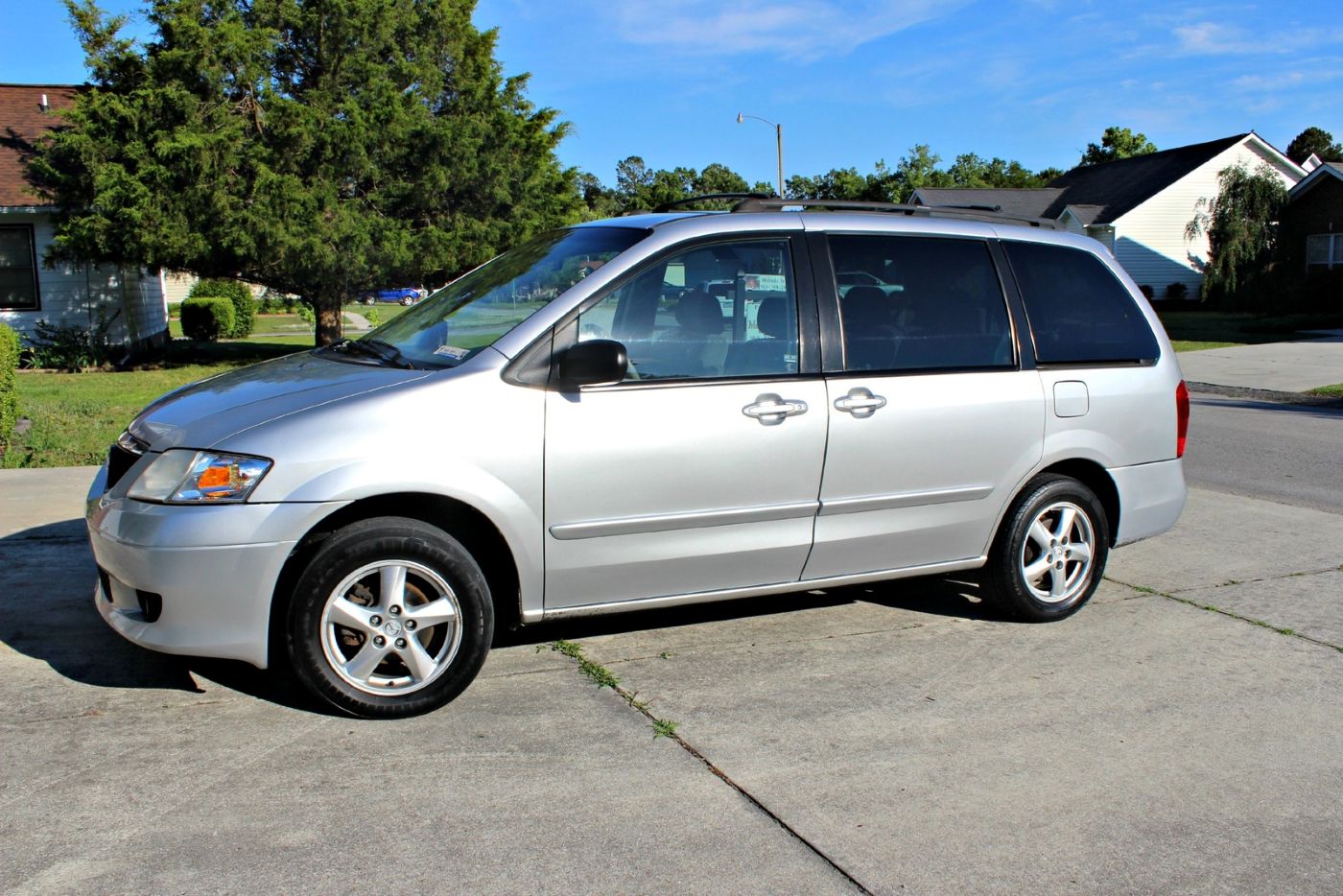Mazda is often viewed as a niche player in the U.S. car market, known more for its fun-to-drive dynamics than its long-term durability. But here’s the truth: over the years, Mazda has quietly become one of the most consistently reliable brands in the game, particularly with its naturally aspirated engines and practical designs.
While brands like Toyota and Honda still dominate the “million-mile club” in the public imagination, Mazda has quietly earned its seat at the table. That said, not every model has aged gracefully.
Mazda Cars Known for Longevity
Some Mazdas, especially from the early 2000s or co-developed with Ford, came with significant reliability issues. Below, we explore five Mazda models known for longevity and five that didn’t live up to expectations.
1. Mazda3 (2004–Present)
The Mazda3 is easily one of Mazda’s most reliable nameplates and is frequently compared to compact giants like the Toyota Corolla and Honda Civic. From its debut in 2004, the Mazda3 gained popularity for its blend of efficiency, sharp styling, and unexpectedly sporty handling.
But what really makes it stand out is its ability to hold up over the years. Especially in models built after 2014, the build quality significantly improved, and with regular maintenance, it’s not uncommon for owners to report 200,000-plus miles.
The naturally aspirated engines are straightforward and dependable, and the manual transmission variants are particularly bulletproof. For shoppers looking for an affordable, long-lasting compact, the 2014–2018 Mazda3s are especially strong candidates.
Following a proud lineage of agile compact cars from Mazda, the Mazda 3 stepped in to replace the Protegé as the brand’s new entry-level model.
It was introduced in both a four-door sedan and a five-door hatchback configuration, offering consumers some versatility in how they approached economy-class driving. Mazda complemented the 3’s sporty persona by equipping it with a pair of robust and polished engines.
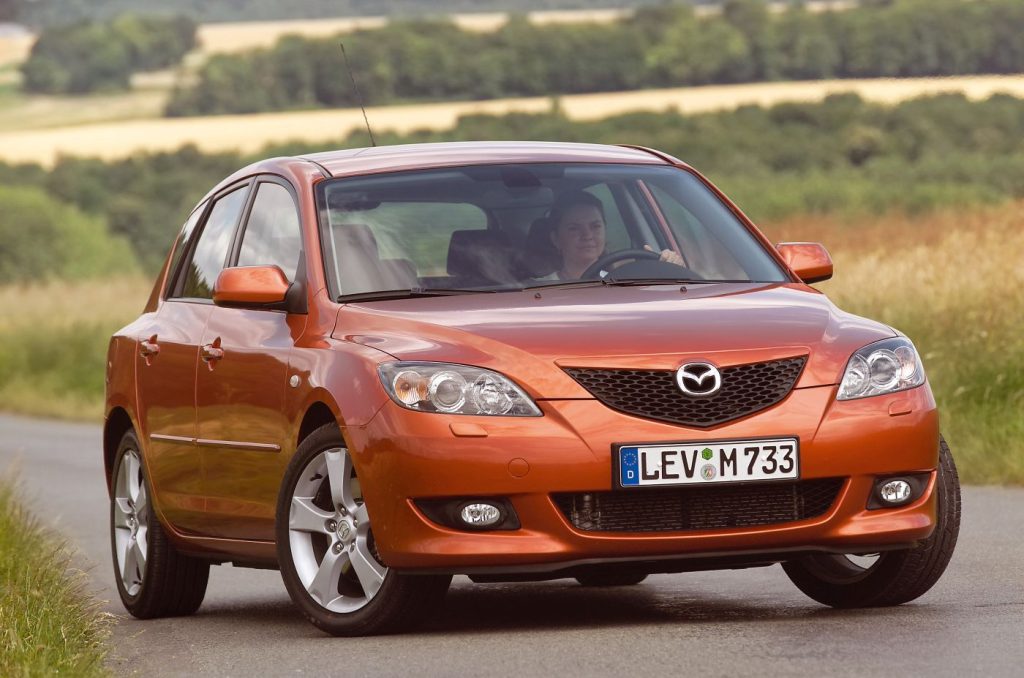
Thanks to finely tuned chassis dynamics, the Mazda 3 delivered impressive handling characteristics: quick steering response, minimal body roll, and confident grip through winding roads.
Yet, it didn’t sacrifice comfort; its highway ride remained composed enough to satisfy the demands of daily commuting.
Unlike the typically uninspired interiors found in many compact cars, the Mazda 3 set itself apart with a thoughtfully designed cabin. It demonstrated a clear focus on aesthetics and functionality. “From the individually recessed gauges to the symmetry of the center stack controls, the attention to detail is evident.”
Additional refinements such as satellite steering wheel controls and a tilt-and-telescoping steering column added a premium touch to a vehicle in this price bracket. Material quality and overall fit-and-finish were exceptional for the segment.
The front seats provided ample space for taller drivers to settle in comfortably, and rear seat accommodations were adequate for the class. Altogether, with its spirited personality, stronger engine options, and revamped interior, the 2006 Mazda 3 earned its role as an economy car that, “puts the ‘zoom-zoom’ back into driving.”
The i sedan variants are powered by a 2.0-liter four-cylinder engine rated at 150 horsepower, while the s models step up to a 2.3-liter four-cylinder engine producing 160 horsepower. Both powerplants come mated to a standard five-speed manual transmission.
For those who prefer an automatic, a four-speed automatic with automanual functionality is available on the i models, whereas s models benefit from an upgraded five-speed automatic transmission.
Also Read: 5 Trucks With the Best Factory Docking Stations and 5 Bare Consoles
2. Mazda MX-5 Miata (1990–Present)
The MX-5 Miata is legendary for many reasons, and longevity is one of them. Unlike many sports cars that are a headache to maintain, the Miata is famously reliable. Its design is clean and minimal, there’s no forced induction or complicated drivetrain tech, just a naturally aspirated engine and rear-wheel drive simplicity.
That makes it both an enthusiast’s dream and a long-term keeper. Whether you’re looking at the classic NA generation or the modern ND, most Miatas are capable of clocking 250,000+ miles with nothing more than regular maintenance.
Parts are cheap, the community support is massive, and the engine platforms have remained consistent and reliable throughout. It’s one of the few sports cars you can confidently daily drive for decades.
When Mazda made its bold 1989 announcement that it was reviving the classic roadster, automotive purists across the globe reacted with disbelief.
“A Japanese company trying to capture the essence of MG, Fiat, Alfa Romeo and Lotus two-seaters of the ’60s? Blasphemy!” The very idea seemed sacrilegious to fans of the original European icons.
But then came the reality of the ’90s, an era where, for less than the cost of a Ford Taurus LX, you could get a car that offered pure, unfiltered driving joy.
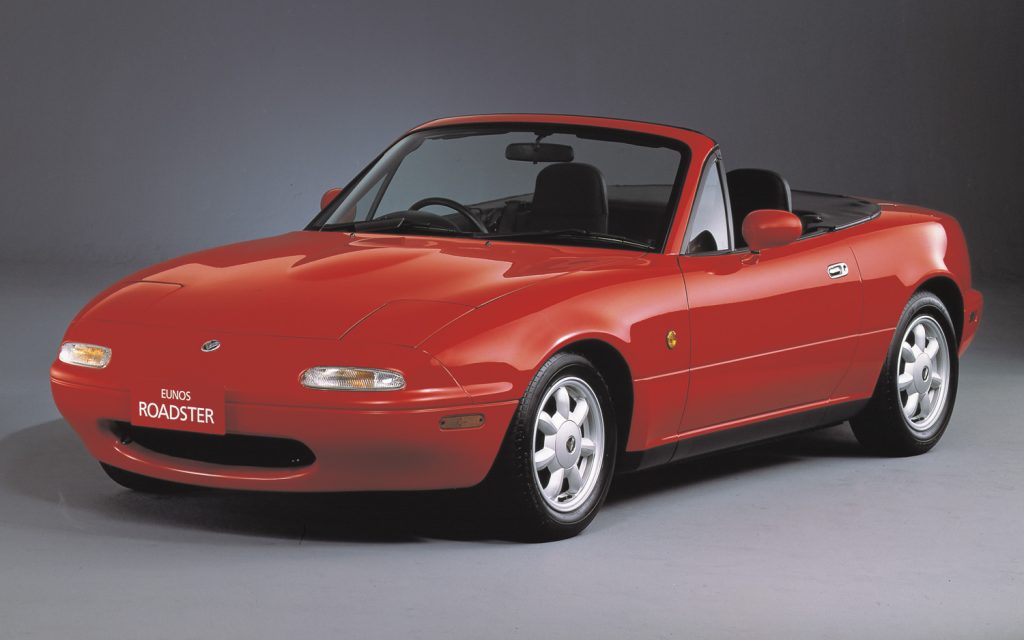
As it turned out, the skeptics were in for a surprise. “Welcome to the ’90s, when you can buy the most driving fun you’ve ever had for less than a Ford Taurus LX.”
Unlike the finicky classics it was inspired by, the MX-5 Miata proved to be a model of reliability. “As an added bonus, the MX-5 Miata doesn’t leak oil from the engine bay or water from the roof.
It doesn’t overheat, fry its electrical system, or scare you in the twisties. You can drive it all day without carrying tools, Go Jo, or Doan’s pills. The MX-5 Miata is truly a modern automotive miracle.”
For the 1995 model year, the Miata continued to evolve with subtle refinements. Mazda introduced updated option packages, building on the enhancements made the previous year, which had included the addition of a passenger-side airbag, improved side-impact protection, fresh alloy wheel designs, and a more powerful engine delivering an extra 12 horsepower.
One standout feature carried over was the R-Package, an enthusiast-focused trim that transformed the Miata into a track-ready machine with specialized suspension and drivetrain upgrades.
Leather seating remained available for those seeking a touch of luxury, and a new exterior paint, Montego Blue, was added to the palette, which already included black, red, medium blue, and white.
In truth, there’s nothing quite like the Miata on the market. While you could opt for a vintage roadster and spend countless hours fixing it, Mazda offered a simpler solution: the real roadster experience without the hassle.
“Unless you enjoy project cars that never allow you to complete the project, the MX-5 Miata is the only way to go to obtain the true roadster experience.”
3. Mazda6 (2009–2019)
The Mazda6 has had its ups and downs, but the second- and third-generation models—particularly those built after 2009—have proven to be incredibly durable sedans. The 2.5L four-cylinder engine is a major contributor to its longevity, offering a great balance of performance and reliability.
These cars have solid transmissions, relatively few recalls, and a smooth highway ride that makes them popular with long-distance commuters.
Another big plus is that Mazda largely fixed the rust issues that plagued earlier models after 2008. The 2014–2017 Mazda6 stands out for its refined design and consistent performance. With routine oil changes and basic upkeep, these sedans can easily exceed 200,000 miles.
Under the hood, the front-wheel-drive 2009 Mazda 6 offers buyers two engine options: a 2.5-liter four-cylinder or a more potent 3.7-liter V6. The four-cylinder generates 170 horsepower and 167 pound-feet of torque, while the V6 ups the ante with 272 horsepower and 269 pound-feet.
Four-cylinder models come standard with a six-speed manual transmission, and all except the base i SV trim offer an optional five-speed automatic. For those opting for the V6, a six-speed automatic transmission is standard.
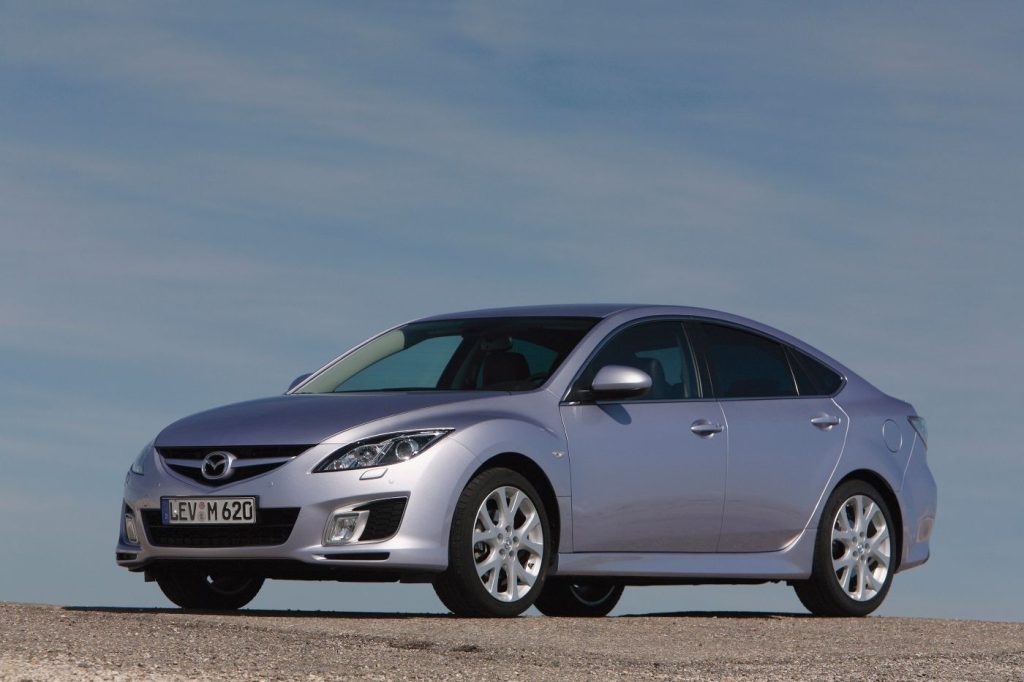
When it comes to fuel efficiency, the four-cylinder model with the manual transmission is rated at 20 mpg in the city, 29 mpg on the highway, and 23 mpg combined. Choosing the five-speed automatic slightly improves efficiency to “21 mpg city/30 highway and 24 combined.”
These figures are solidly competitive for the class. However, fuel economy takes a hit with the V6: “Estimates drop to 17 mpg city/25 highway and 20 combined, which is about as bad as it gets in this segment.”
Mazda equips the 2009 6 with a comprehensive list of standard safety features. These include antilock disc brakes, stability control, front-seat side airbags, and full-length side curtain airbags—delivering peace of mind whether you’re navigating crowded urban streets or cruising on the highway.
While the Mazda 6 delivers a well-balanced driving experience, it’s not without its quirks. One issue is that “a notable amount of road noise filters into the 6’s cabin at speed.”
The base 2.5-liter engine, though efficient, tends to sound strained and delivers only modest acceleration. However, the “slick-shifting six-speed manual shifter livens things up a bit.” Those who prefer an automatic will find the five-speed version less engaging but “remarkably refined” in its shift quality.
For buyers seeking more muscle, the V6 doesn’t disappoint. “The big 3.7-liter V6 feels and sounds muscular, yet it’s a smooth operator, even at higher engine speeds.”
Unfortunately, the six-speed automatic paired with the V6 doesn’t match that enthusiasm, it’s not tuned for spirited driving, and “downshifts are delayed, even in manual mode.”
4. Mazda CX-5 (2013–Present)
The CX-5 is Mazda’s best-selling model in the U.S., and it’s not hard to see why. It combines attractive styling, great fuel economy, and Mazda’s signature driving dynamics, all wrapped in a practical crossover package. But what really seals the deal for many owners is its long-term reliability.
The CX-5’s naturally aspirated SkyActiv engines are well-regarded for their durability, and the transmission is generally trouble-free. Even the available all-wheel-drive system has proven to be dependable, which isn’t always the case in compact SUVs.
The 2016–2021 models are particularly well-regarded, offering updated tech, improved safety features, and a better ride without sacrificing reliability. Many owners report getting 150,000 to 200,000 miles without major repairs.
The 2013 CX-5 may not be Mazda’s first foray into the compact crossover SUV category, but it’s the first one that truly hits the mark.
Built on an entirely new unibody platform, the CX-5 was designed from the ground up to blend interior space, engaging handling, and lightweight construction into one cohesive package
For 2013, it launches with a single powertrain: a fuel-efficient, direct-injected 2.0-liter four-cylinder engine that delivers 155 horsepower and 150 pound-feet of torque.
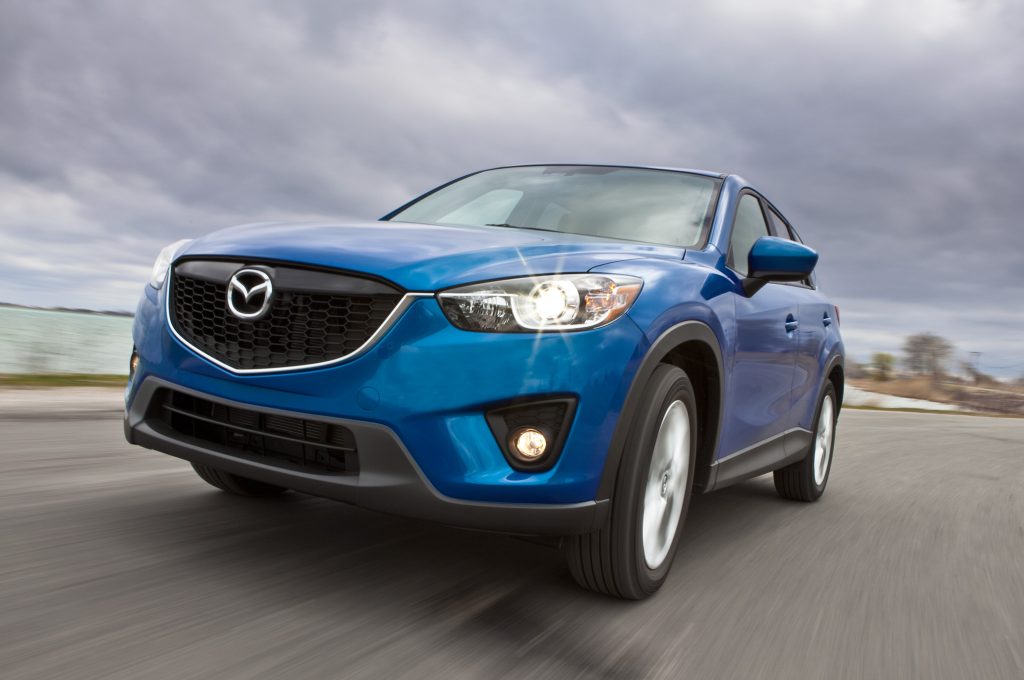
This engine helps position the CX-5 as one of the most efficient in its class. “EPA-estimated fuel economy is 29 mpg combined with front-wheel drive, putting the CX-5 at the top of its class for efficiency.”
Often, shopping in the compact SUV category means compromising on tech or features, especially at the entry level. That’s not the case here.
“Choosing a vehicle in the compact SUV segment can sometimes mean settling for less when it comes to modern amenities. Not so with the CX-5.” Even the base trim comes with a surprisingly generous list of standard features, appealing to buyers who want value without feeling like they’ve skimped.
As you move up through the trims, the list of amenities grows considerably. At the top, the Grand Touring model is “equipped essentially like a luxury model,” delivering premium features usually reserved for more expensive vehicles.
When it comes to utility and cargo flexibility, the CX-5 competes well with its peers. The entry-level Sport trim comes with 60/40-split-folding rear seats, offering basic versatility.
For buyers who need more practicality, like those who regularly hit the slopes, the higher Touring and Grand Touring trims feature a more versatile setup: “a special 40/20/40-split-folding rear seat to accommodate long objects in the cargo area.”
Although the CX-5’s maximum cargo space doesn’t quite top the charts in this class, “it’s not far off,” making it a strong contender for those seeking a balance of practicality, efficiency, and driving fun.
5. Mazda Protegé (1999–2003)
Before the Mazda3 came along, the Protegé filled the role of Mazda’s dependable compact. It was never flashy, but it was consistent, cheap to maintain, and hard to kill. Powered by small displacement engines like the 1.6L or 2.0L inline-fours, these cars were all about simplicity.
They had few electronic components to fail, and parts were widely available and affordable. The Protegé5 hatchback, in particular, has become something of a cult favorite for its versatility and slightly sportier styling.
While they’re getting rare on the roads today, those still running are a testament to how well-built these cars were. If you find one that’s been cared for, it can be a surprisingly smart buy on the used market.
Now entering its second model year, Mazda’s current-generation Protege continues to stand out as a lively compact sedan competing directly with heavy hitters like the Honda Civic, Toyota Corolla, and Ford Focus.
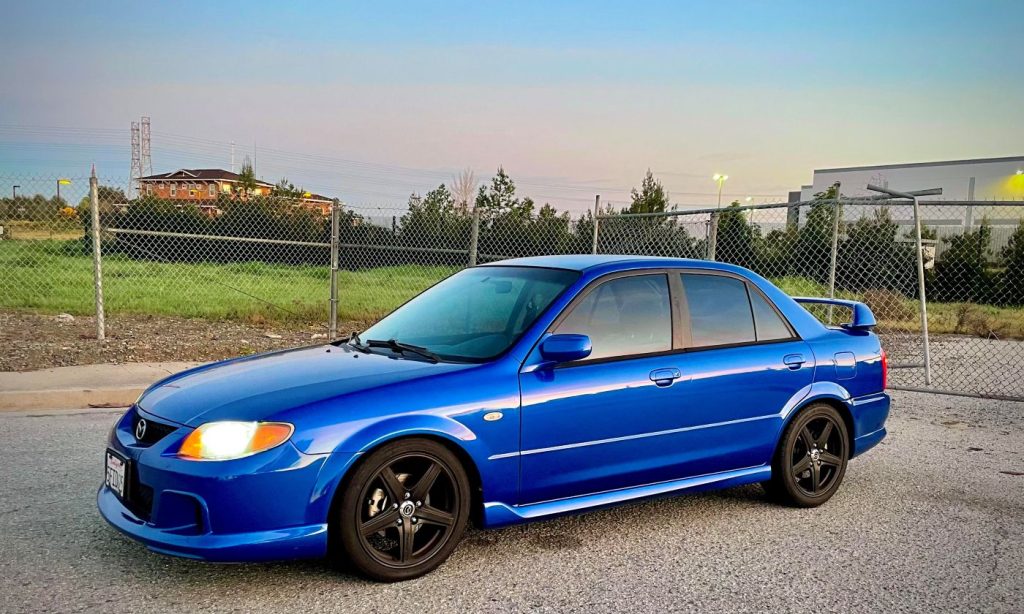
Though it’s offered solely as a four-door sedan, buyers still have options when it comes to trim levels, with three choices available: DX, LX, and ES. The entry-level DX includes basic essentials such as power steering, a tilt steering wheel, and a split folding rear seatback.
If you’re after more convenience and comfort, like a driver’s height-adjustable seat, power windows and door locks, a tachometer, or cruise control, you’ll need to move up to either the LX or ES trims. “The ES also comes with features like standard air conditioning, 15-inch alloy wheels, and optional ABS.”
Under the hood, both the DX and LX are powered by a 1.6-liter four-cylinder engine producing 105 horsepower and 107 pound-feet of torque. While this engine offers passable performance for day-to-day driving, those who want a bit more punch should turn to the ES model.
“This version gets a 1.8-liter engine that puts out 122 horsepower and 120 foot-pounds of torque.” That extra power makes a noticeable difference in acceleration and overall responsiveness.
Mazda Cars That Had Reliability Troubles
While Mazda has produced many dependable vehicles, not every model has been a winner. Some Mazdas—particularly those from the early 2000s or built through partnerships with Ford, suffered from engine issues, transmission failures, and premature rust.
These models earned a reputation for being high-maintenance and often cost more in repairs than they were worth. Here’s a look at five Mazda vehicles that struggled with reliability over the years.
1. Mazda CX-7 (2007–2012)
The CX-7 is a prime example of what happens when good intentions meet poor execution. It looked sharp and drove well, but it was plagued by a slew of reliability issues, particularly with its 2.3L turbocharged engine. The turbo itself was prone to failure, especially in vehicles where oil changes weren’t performed frequently.
Timing chain issues and engine sludge buildup were also common, often leading to catastrophic engine failure. The AWD system didn’t help either, with several reports of drivetrain issues. Despite its sporty promise, the CX-7 turned out to be a money pit, and even today, it’s a hard sell on the used market.
Powering the CX-7 is a single drivetrain setup: “a turbocharged, direct-injection 2.3-liter inline four good for 244 horsepower and 258 lb-ft of torque.”
This engine is paired with a six-speed automatic transmission that includes manual shift capability as standard. Buyers can choose between front-wheel drive or all-wheel drive, though “there is no low-range gearing, confirming the on-road mission of the CX-7.”
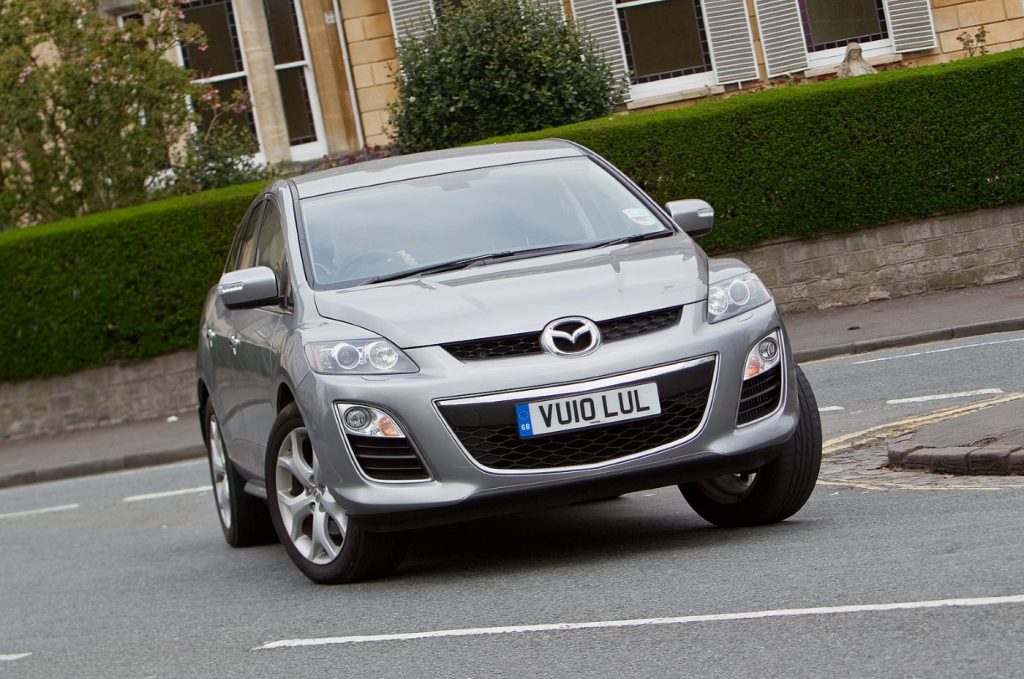
Under normal conditions, the AWD system sends “100 percent of the engine’s power to the front wheels,” but when slip is detected, “up to 50 percent of engine power is automatically and quickly applied to the rear wheels.”
Despite the heft—especially in fully loaded Grand Touring AWD models that tip the scales near two tons—the CX-7 still delivers a respectable level of performance.
“Zero to 60 mph takes just 7.7 seconds,” which is quick for this class. Braking capability is equally impressive, earning high marks with “fade-free stops from 60 mph of 113 feet,” which rivals some performance sedans.
However, fuel efficiency is a clear weak point. “The EPA rates the CX-7 AWD as returning 18 mpg city/24 mpg highway,” which lands on the lower end for compact crossovers. Another limitation is its towing capacity—“the CX-7 is limited to 2,000 pounds,” making it less suitable for those with heavier hauling needs.
2. Mazda MPV (1996–2006)
Mazda’s foray into the minivan market was met with mixed results. The MPV was never a huge seller, and reliability was one of the reasons why. While early models had quirky rear-wheel-drive layouts, later versions went front-wheel-drive and borrowed heavily from Ford.
That’s where the trouble began. Transmission issues were common, and the V6 engines had a reputation for overheating and gasket failure.
On top of that, rust was a major issue, particularly in salt-belt states like Michigan and New York. Electrical issues and poor build quality rounded out the MPV’s list of troubles. It’s best to avoid this one unless you’re okay spending more on repairs than the van is worth.
The MPV is the closest thing to an SUV that Mazda has to offer. The lineup consists of two trim levels: a well equipped LX and luxury ES.
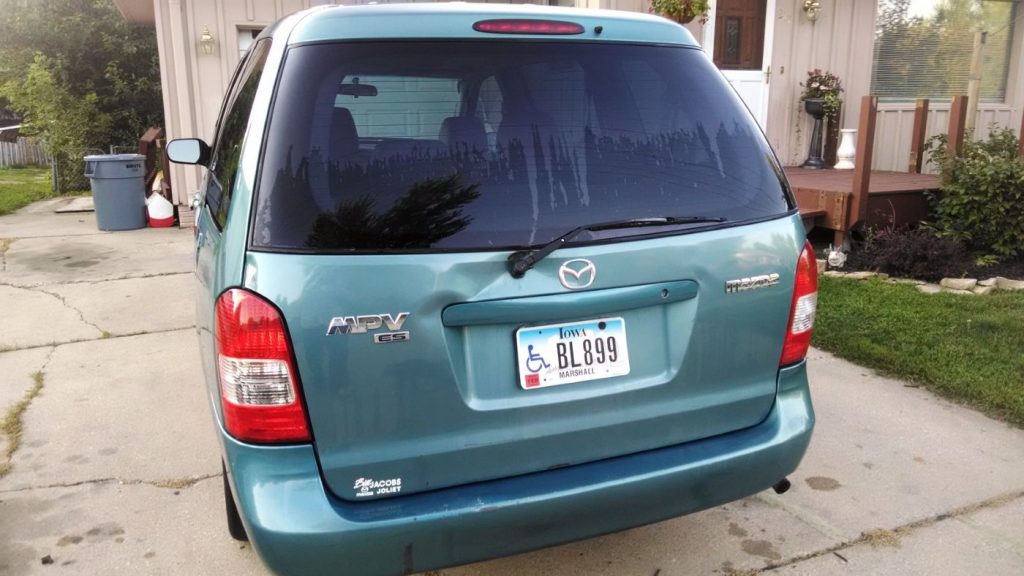
All MPVs with the exception of the LX 2WD come with All Sport decor (a grille guard, fender flares, rear bumper guard, stone guard, roof rack, special graphics and alloy wheels), which turns this Mom-mobile into a four-door van that looks like it can tackle any terrain.
Combine this styling gimmick with shift-on-the-fly four-wheel drive, and the MPV serves reasonably well as a pseudo-Explorer. Four-wheel disc antilock brakes are standard on all models. The ES edition contains such pleasantries as leather seating surfaces and automatic load leveling.
Acceleration with the 155-horsepower, 18-valve, 3.0-liter V6 engine is sufficient. Four-wheel drive cuts into potential performance because of its sizable extra weight.
Gas mileage also dips considerably with 4WD vans. A four-speed automatic with electronic controls is the sole transmission choice. With 4WD, a dashboard switch can lock the center differential, for peak low-speed traction.
3. Mazda RX-8 (2004–2011)
The RX-8 is a textbook example of a car that was fun to drive but painful to own. It featured Mazda’s iconic 1.3L Renesis rotary engine, which sounded great on paper but delivered headaches in practice.
Apex seal failures, oil burning, and engine flooding were common, especially if the car was used for short trips or driven gently. Ironically, babying the RX-8 often led to more problems than driving it hard.
On top of the engine issues, the RX-8 suffered from poor fuel economy and was difficult to maintain due to the rotary engine’s niche requirements. Unless you’re a rotary enthusiast with a second car and a good mechanic, this one is best admired from afar.
With the 2007 Mazda RX-8, the boundary between a sports car and a sport coupe becomes less defined. Traditionally, sports cars are “low-slung, sleekly styled and designed to seat just two adults.” They may offer a rear seat, but it’s typically so cramped that it’s only suitable for “small children or cargo.”
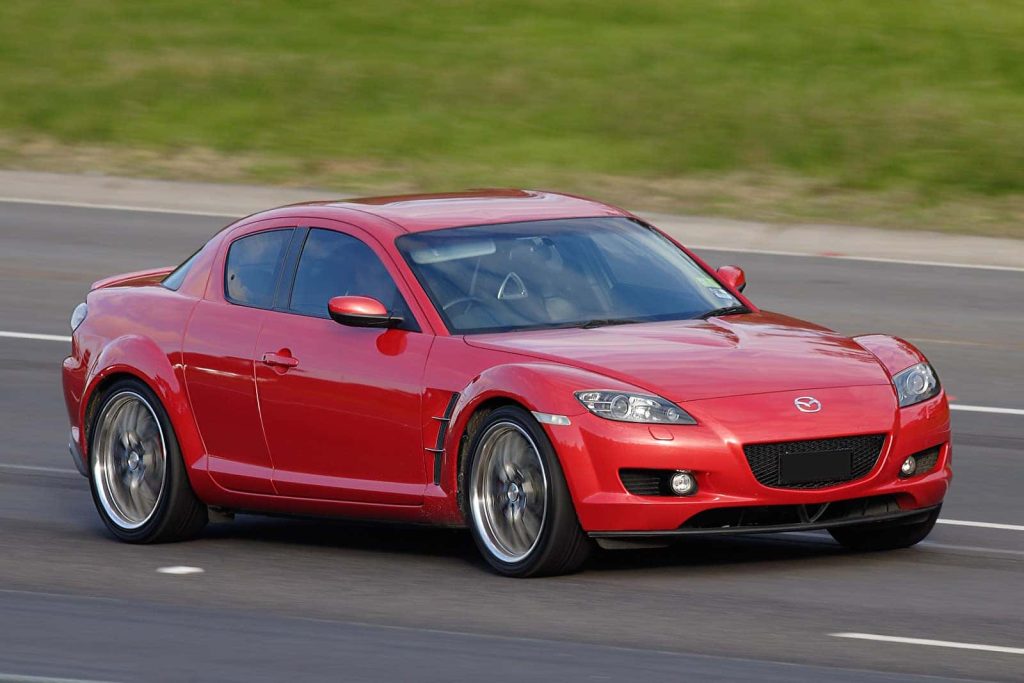
Sport coupes, by contrast, are generally larger and accommodate “four (or five) full-size people.” The RX-8 manages to fuse these two identities into one vehicle—“it’s a true sports car that seats four adults.”
Adding to its uniqueness, it features “a pair of pillar-less rear-opening doors that allow access to its surprisingly roomy backseat.” And if that’s not enough to set it apart, it’s also “the only production car in the world with a rotary engine.”
The RX-series’ rotary engine has long fascinated car enthusiasts, and with good reason. Compared to traditional piston engines, it offers several notable benefits.
4. Mazda Tribute (2001–2008)
The Tribute was Mazda’s version of the Ford Escape, and it unfortunately inherited many of its partner’s problems. The V6 engine in particular was a trouble spot, prone to stalling, rough idling, and early transmission failure. Interior quality was also subpar, with cheap materials and poor fit and finish.
Rust was yet another concern, especially in the Midwest and Northeast. While some later models saw improvement, the early 2000s Tributes have earned a reputation for being high-maintenance and low-reward. In a market full of durable compact SUVs, the Tribute just doesn’t measure up.
The Mazda Tribute was once marketed as the SUV with “the zoom-zoom soul of a sports car, specifically a Miata.” But in truth, its underlying character aligned far more closely with that of the Ford Escape, with which it shared a substantial amount of its platform and components.
This wasn’t necessarily a downside, as the Tribute inherited the Escape’s “comfortable carlike driving experience, and a useful cargo- and people-hauling interior.”
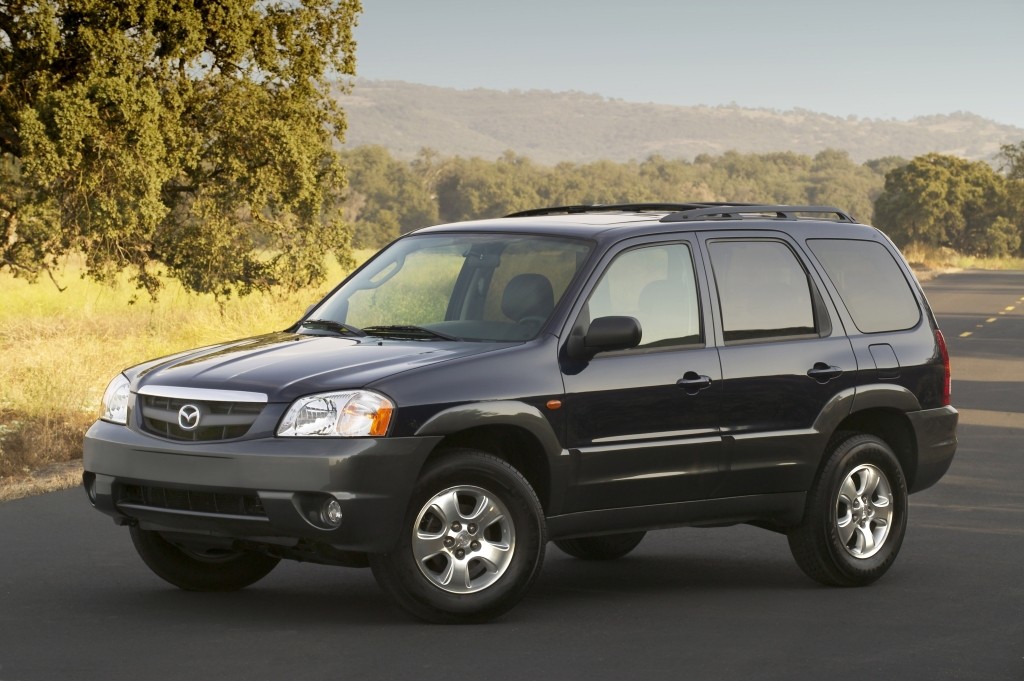
The extensively updated 2008 Mazda Tribute carries on in the same vein, now bearing an even stronger resemblance to the Ford Escape both inside and out.
Though it benefits from “new styling and a greatly improved interior,” the retention of the older “powertrain and chassis further diminish any zoom-zoom claims.” In short, while Mazda may emphasize performance in its branding, this SUV is more about utility and refinement than speed or agility.
With its boxy silhouette and conventional SUV proportions, “the Tribute looks like the shipping container the Mazda CX-7 came in.” It doesn’t quite mesh with the rest of Mazda’s sporty design language, but its fresh exterior nonetheless stands out as “a stylish, alternative take on the new Escape.”
The same holds true for the interior. While earlier models were plagued with “crummy hard plastics,” the 2008 version upgrades to “higher-quality and more stylish materials.”
Complemented by “available rich two-tone color schemes and ‘ice blue’ lighting,” the cabin now projects “a warm, yet modern look,” helping the Tribute feel more upscale and competitive in today’s compact-to-midsize crossover segment.
5. First-Gen Mazda6 (2003–2008)
The first-generation Mazda6 had a lot going for it: good looks, sporty handling, and solid safety ratings. Unfortunately, it also came with reliability baggage. The Ford-sourced V6 engines were a major problem area, with many reports of coolant leaks, overheating, and premature failure.
The automatic transmissions didn’t fare much better, particularly in models from 2004 to 2006. Rust also became a significant issue in the rear wheel wells and underbody.
While some four-cylinder models were more reliable, the first-gen Mazda6 overall didn’t live up to the standard set by later versions. If you’re considering one, proceed with caution and get a thorough inspection. Mazda has carved out a unique place in the U.S. auto market—one that balances driving enjoyment with increasing reliability.
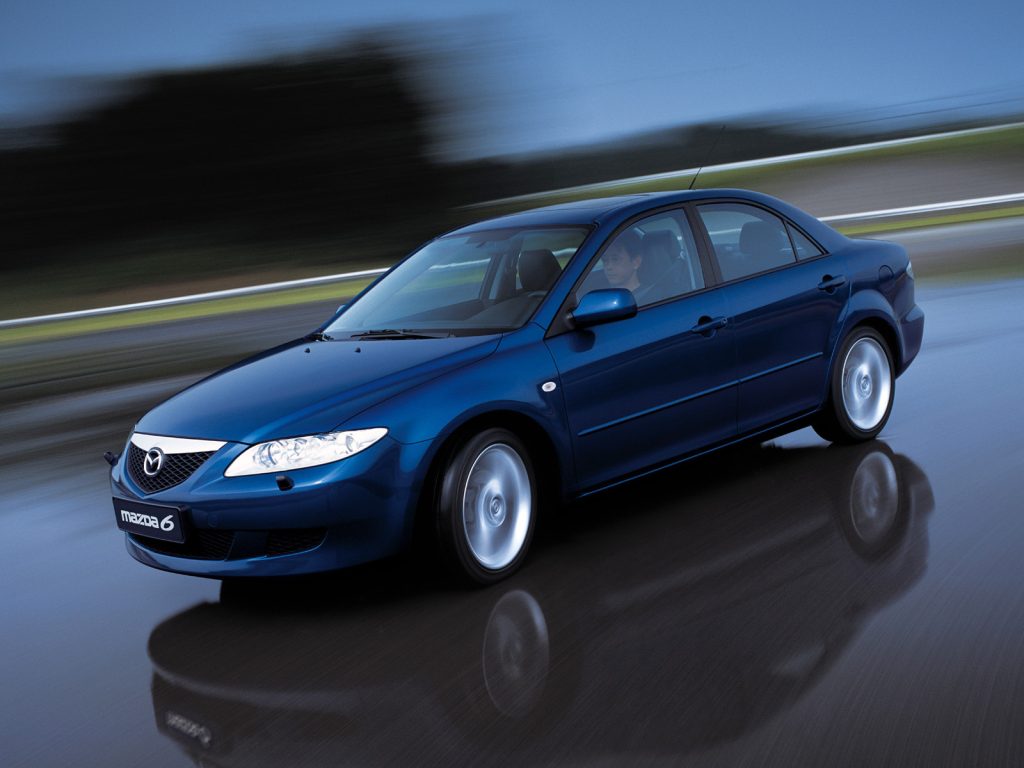
The first-generation Mazda 6, introduced in 2002, marked a significant turning point for the brand, establishing a new benchmark in the midsize sedan category.
Serving as the successor to the Mazda 626, it quickly gained popularity thanks to its engaging driving dynamics, attractive styling, and practical versatility. Offered in multiple body styles—sedan, hatchback, and wagon—it catered to a broad spectrum of buyer preferences.
Beneath the hood, the Mazda 6 came with a variety of engine choices. Entry-level versions featured a 2.0-liter four-cylinder, while a more robust 2.3-liter four-cylinder was available for those seeking a stronger blend of performance and fuel economy.
Higher trims boasted a 3.0-liter V6 engine, delivering a notably sportier driving experience. The car’s handling stood out in the segment, praised for its sharp agility, thanks largely to its well-tuned suspension and precise steering setup.
Inside, the Mazda 6 was designed with comfort and functionality at its core. It featured a spacious cabin, intuitive controls, and a smartly arranged dashboard that enhanced everyday usability. Safety was also a priority, with standard features including anti-lock brakes, front airbags, and side-impact airbags.
The first-generation Mazda 6 raised the bar for the brand moving forward, offering a compelling mix of style, performance, and reliability that resonated strongly with both reviewers and everyday drivers alike.
Especially in the past 10–15 years, the brand has shaken off its earlier reputation for rust and fragile engines, becoming a serious contender for buyers who want something a little more engaging than a Toyota but just as dependable.
Also Read: 5 Cars That Don’t Burn Oil Even at High Mileage and 5 That Constantly Need Top-Ups
Still, not all Mazdas are created equal. Models like the MX-5, Mazda3, and CX-5 prove that you can get long-term reliability without sacrificing fun. On the flip side, turbocharged engines, rotary setups, and early Ford-era collaborations often turned out to be trouble.
If you’re shopping for a used Mazda or trying to decide between a few models, keep it simple: stick to naturally aspirated engines, avoid complex AWD setups unless you really need them, and check for rust.
A clean, well-maintained Mazda from the past decade can easily last you another 100,000+ miles—and might even be the most enjoyable car you’ll ever own.

